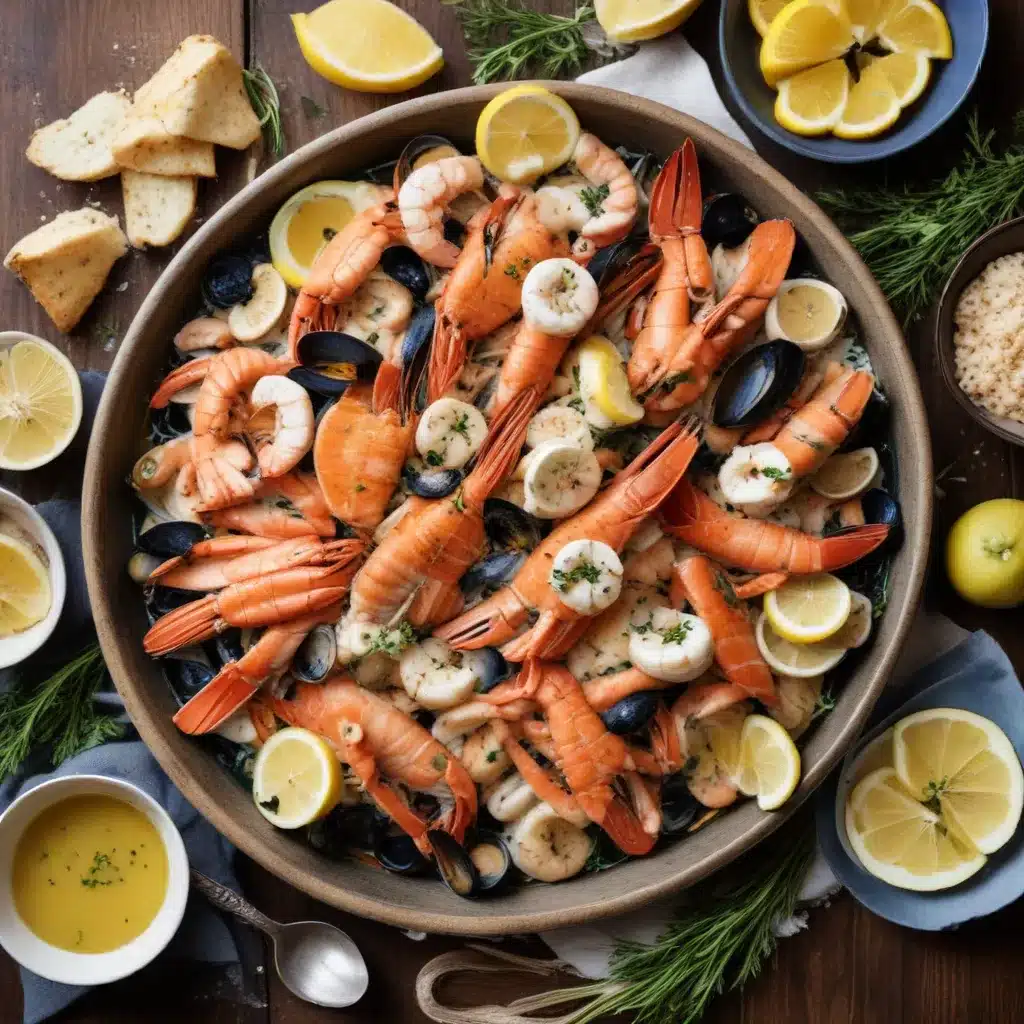
Seafood enthusiasts with gluten sensitivities need not miss out on the delicious wonders of the ocean. With a few clever techniques and creative ingredient substitutions, you can enjoy a wide array of gluten-free seafood dishes that are every bit as flavorful and satisfying as their wheat-based counterparts.
Seafood Ingredient Selection
At the heart of any great gluten-free seafood feast is the quality of the seafood itself. When sourcing your ingredients, look for fresh, responsibly-sourced options that align with your dietary needs. For example, cod is a versatile white fish that lends itself beautifully to gluten-free preparation methods.
Not only is cod an excellent source of lean protein, but it’s also rich in essential vitamins and minerals like vitamin B12, phosphorus, and selenium. When shopping for cod, opt for fillets or steaks that are firm to the touch, with a fresh, briny aroma. Avoid any pieces that appear discolored or have a strong “fishy” odor, as these can indicate spoilage.
Gluten-Free Cooking Methods
Preparing gluten-free seafood doesn’t have to be complicated. In fact, many traditional cooking techniques – such as baking, grilling, and sautéing – are naturally gluten-free. The key is to select appropriate breading or coating ingredients that will provide a crispy texture without the use of wheat flour.
One popular gluten-free breading option is to use finely crushed gluten-free crackers or cereal. Simply pulse the crackers or cereal in a food processor until they reach a breadcrumb-like consistency, then use the mixture to coat your seafood before baking or pan-frying. Alternatives like almond meal, coconut flour, or even crushed gluten-free pretzels can also work beautifully.
For a more hands-off approach, try baking your seafood en papillote – that is, wrapped in parchment paper or foil packets. This method allows the fish to steam in its own juices, infusing it with flavor while keeping it moist and tender. You can also experiment with gluten-free marinades or sauces to add even more depth of flavor.
Dietary Considerations
When catering to gluten-free diners, it’s important to keep a few additional dietary concerns in mind. Some individuals with gluten sensitivities may also need to avoid other common allergens, such as dairy or soy. In these cases, be mindful of your ingredient choices and consider offering dairy-free or soy-free alternatives as well.
For those following a low-carb or keto lifestyle, seafood can be an excellent protein source. Try serving your gluten-free fish or shellfish alongside roasted vegetables, zucchini noodles, or a fresh salad to create a well-balanced, satisfying meal.
Gluten-Free Seafood Recipes
Bring your gluten-free seafood feasts to life with these delectable recipes:
Grilled Seafood Dishes
- Lemon-Herb Grilled Cod – Marinate cod fillets in a blend of lemon juice, olive oil, garlic, and fresh herbs before grilling to perfection.
- Shrimp Skewers with Pineapple Salsa – Thread juicy shrimp onto skewers and grill alongside slices of fresh pineapple. Top with a vibrant, gluten-free salsa.
Baked Seafood Entrees
- Baked Cod with Almond Parmesan Crust – Coat cod fillets in a mixture of almond meal, grated Parmesan, and spices before baking for a crispy, flavorful crust.
- Salmon en Papillote with Fennel and Dill – Wrap salmon fillets in parchment paper or foil with sliced fennel, fresh dill, and a splash of white wine.
Sautéed Seafood Options
- Garlic Butter Sautéed Scallops – Quickly sear sea scallops in a gluten-free garlic butter sauce for a decadent, restaurant-quality dish.
- Sautéed Cod with Tomato Basil Relish – Pan-sear cod fillets and top with a vibrant relish of diced tomatoes, fresh basil, and a drizzle of balsamic glaze.
Gluten-Free Flavor Profiles
Exploring the world of gluten-free seafood doesn’t mean sacrificing flavor. In fact, there are many ways to enhance the natural taste of your fish and shellfish through the strategic use of herbs, spices, sauces, and garnishes.
Herbs and Spices
Brighten up your gluten-free seafood dishes with the addition of fresh herbs like parsley, dill, basil, or cilantro. Dried spices like garlic powder, paprika, cumin, or chili powder can also lend a flavorful punch. For a touch of heat, try incorporating red pepper flakes or cayenne pepper.
Sauces and Marinades
Gluten-free citrus-based marinades or vinaigrettes can help to tenderize seafood and infuse it with zesty, tangy flavors. For a creamy alternative, consider a yogurt-based sauce or lemon-dill aioli. Those following a low-carb lifestyle may enjoy a pesto or chimichurri sauce to drizzle over their seafood.
Garnishes and Accompaniments
Elevate your gluten-free seafood dishes with vibrant garnishes like diced avocado, chopped mango, toasted nuts or seeds, or fresh herbs. On the side, serve roasted vegetables, quinoa, or a leafy green salad to create a well-rounded, nutrient-dense meal.
Sustainable Seafood Sourcing
When planning your gluten-free seafood feasts, it’s essential to consider the environmental impact of your ingredient choices. Look for sustainably-sourced options that are caught or farmed in a responsible manner, minimizing harm to marine ecosystems.
Environmental Impact
Opt for seafood that is rated as “best choice” or “good alternative” by organizations like the Monterey Bay Aquarium’s Seafood Watch program. Avoid overfished species or those caught using destructive methods, such as bottom trawling.
Local and Seasonal Seafood
Whenever possible, source your seafood from local or regional suppliers who can provide insight into their fishing or aquaculture practices. Eating seafood that is in season not only ensures optimal freshness and flavor, but also supports more sustainable harvesting.
Responsible Aquaculture
For farmed seafood, look for certifications from organizations like the Aquaculture Stewardship Council (ASC) or Global Aquaculture Alliance (GAA). These indicate that the seafood was raised in an environmentally and socially responsible manner.
By keeping these considerations in mind, you can enjoy delicious, gluten-free seafood dishes while also supporting the long-term health of our oceans and waterways. For more information on sustainable seafood options, visit Fish Tales Cafe.

